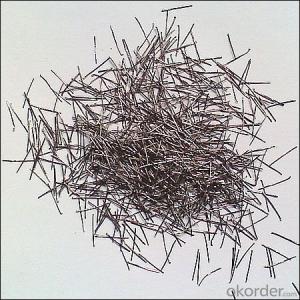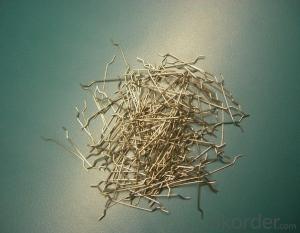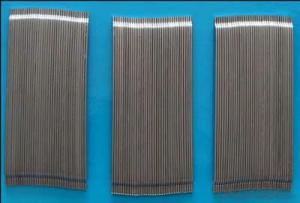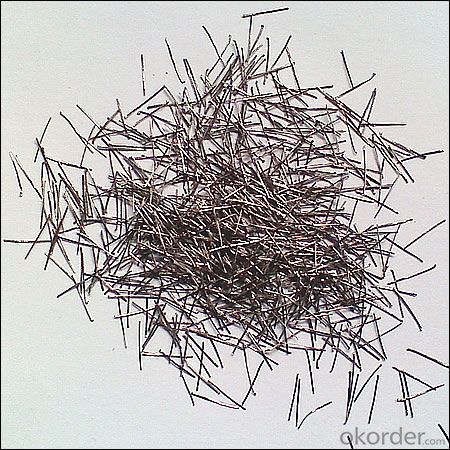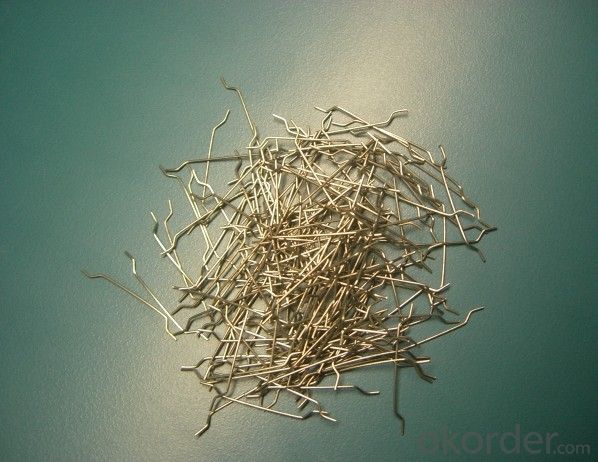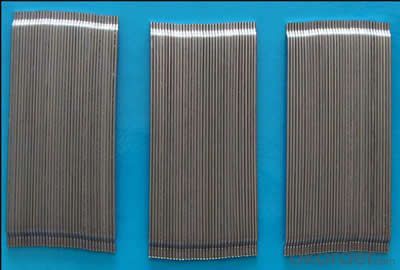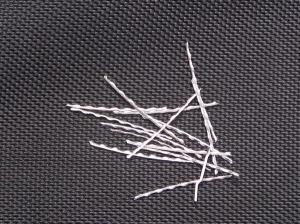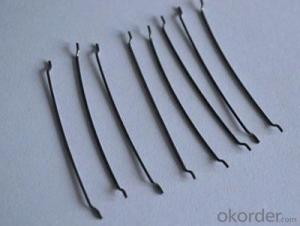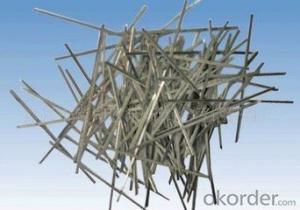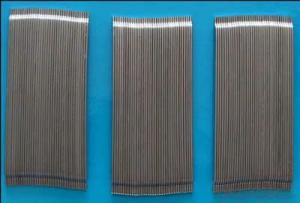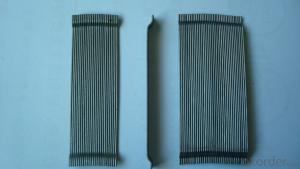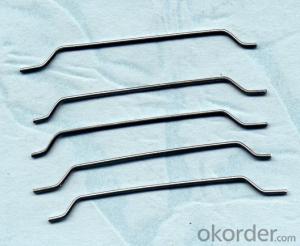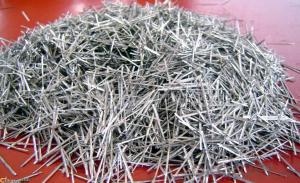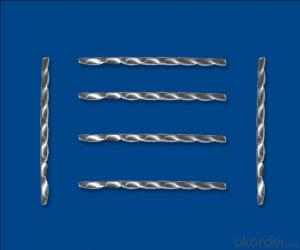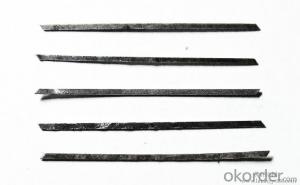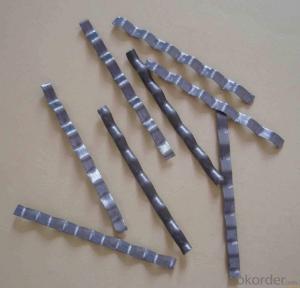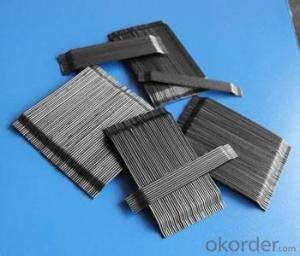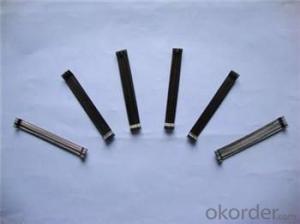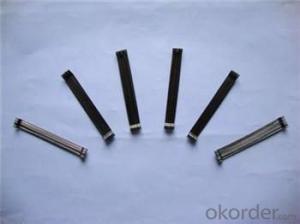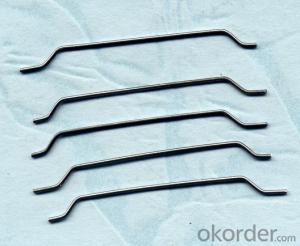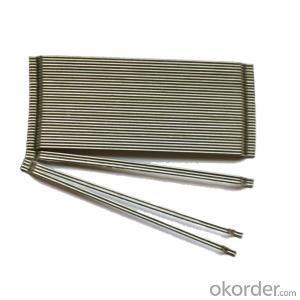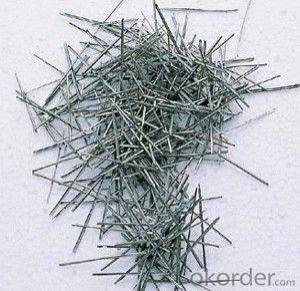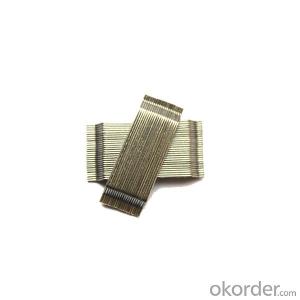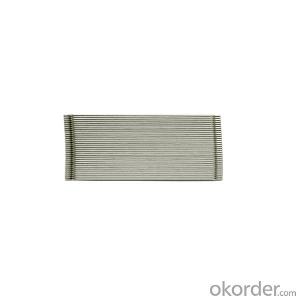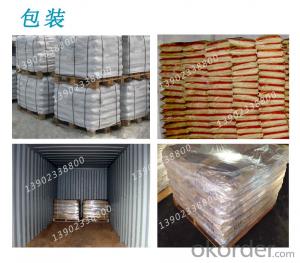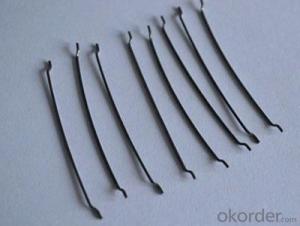Melt Extract Stainless Steel Fiber Airport Runway Cement Buildings
- Loading Port:
- Tianjin
- Payment Terms:
- TT OR LC
- Min Order Qty:
- 1000 kg
- Supply Capability:
- 250000 kg/month
OKorder Service Pledge
OKorder Financial Service
You Might Also Like
Quick Details
Place of Origin: Shandong, China (Mainland)
Model Number: steel fiber
material: steel wire
application: concrete reinocement
type: end hook steel fiber
Product features
steel fiber for conatruction and concrete reinforcement,widely uesd in concrete to improve its stabality end hooked steel fiber ,with its high tensile strength ,good scattering and good combination with cenment material concrete steel fiber is specifically designed to enhance concrete in its hardened state ,the uniform distribution of steel fibers throughout the concrete greatly improve concrete bonding and tensile strengh ,addtionally it provides eceptional load stability and durability ,as reliable and efficient concrete reinforement materisl ,it is widely used in buildings ,bridges,thin roof engineering ,highy way etc.
Specifications
1.hooked steel fiber
2.CE and ISO9001:2008
3.diameter from 0.5mm to 1.2mm
4.competitive price,high quality and service
Hooked Steel Fiber:
1.Diameter:0.5mm-1.0mm
2.Length: 25mm-60mm
3.Material: low carbon steel wire
4.Feature: excellent tensile,high tenacity,against cracking,impact and fatigue
5.Uses: high way,tunnel,building,airport road serface and so on .
Picture
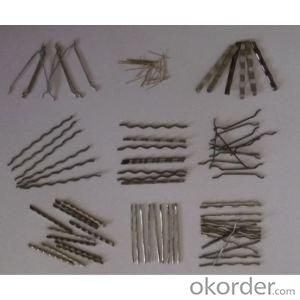
steel fiber concrete reinforced
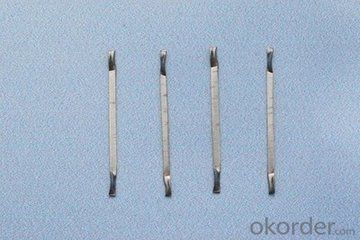
any type steel
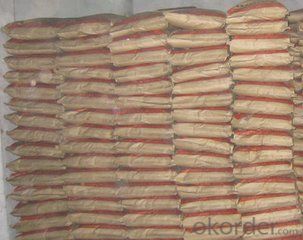
FAQ
we can produce any type steel fiber and of course we can make production according to your requirement
we have specilize in this field for almost 10 years ,with good quality and competitive price
- Q: Can melt extract stainless steel fiber be used in sports field pavements?
- Yes, melt extract stainless steel fiber can be used in sports field pavements. Stainless steel fibers are known for their high strength and durability, making them an excellent choice for applications that require resistance to wear and heavy traffic, such as sports field pavements. These fibers can improve the overall performance and lifespan of the pavement by enhancing its toughness, crack resistance, and fatigue resistance. Additionally, the corrosion resistance of stainless steel ensures that the fibers will not deteriorate over time, even in harsh weather conditions. Overall, using melt extract stainless steel fiber in sports field pavements can help create a more robust and long-lasting surface that can withstand the rigorous demands of sports activities.
- Q: How does the addition of melt extract stainless steel fiber affect the rheology of concrete?
- The addition of melt extract stainless steel fiber significantly affects the rheology of concrete by improving its overall performance and durability. One of the main effects of incorporating stainless steel fibers is the enhancement of concrete's tensile and flexural strength. The fibers act as reinforcement within the concrete matrix, effectively bridging cracks and increasing its resistance to cracking and fatigue. This results in a more ductile and robust material that can withstand higher loads and stresses without failure. Moreover, the addition of stainless steel fibers also improves the rheological properties of concrete. These fibers, being extremely fine and flexible, enhance the workability of the mix by reducing the viscosity and improving the flowability. This makes the concrete easier to pump, place, and compact, ultimately leading to better consolidation and higher quality finishes. Additionally, the presence of stainless steel fibers in concrete can modify its setting and hardening characteristics. The fibers act as nucleation sites for hydration products, accelerating the cement hydration process and promoting early strength development. This can be particularly beneficial in construction projects where fast setting times are required or in cold weather conditions where concrete may be prone to freezing. Furthermore, the stainless steel fibers also contribute to the overall durability of concrete. They provide a physical barrier against corrosion by reinforcing the concrete and preventing the ingress of moisture and aggressive chemicals, thus increasing the lifespan of the structure. This is especially crucial in harsh environments or in structures exposed to chemical attacks, such as wastewater treatment plants or marine structures. In conclusion, the addition of melt extract stainless steel fibers brings numerous benefits to the rheology of concrete. It improves its strength, workability, and durability, making it a reliable and high-performance construction material.
- Q: How does melt extract stainless steel fiber improve the resistance to fatigue in shotcrete?
- Melt extract stainless steel fiber improves the resistance to fatigue in shotcrete by providing additional reinforcement in the concrete matrix. Shotcrete is a method of applying concrete in a sprayed form, and it is commonly used in construction projects where high strength and durability are required. However, shotcrete is prone to fatigue and cracking due to repeated loading and cyclic stresses. By incorporating melt extract stainless steel fibers into the shotcrete mix, the overall fatigue resistance of the material is significantly enhanced. These fibers act as discrete reinforcement, distributing the applied stresses more evenly throughout the concrete. This helps to mitigate the formation and propagation of cracks, thereby improving the overall durability and lifespan of the shotcrete structure. The unique properties of melt extract stainless steel fibers contribute to their effectiveness in enhancing fatigue resistance. These fibers are made from high-quality stainless steel, which has excellent tensile strength and corrosion resistance. Additionally, the melt extract manufacturing process ensures the fibers have a smooth surface and uniform geometry, allowing for better bonding with the concrete matrix. Furthermore, the addition of melt extract stainless steel fibers can also improve the flexural strength of shotcrete, making it more resistant to bending and flexing stresses. This is particularly important in applications such as tunnel linings, underground structures, and retaining walls, where shotcrete is exposed to significant cyclic loading. In summary, melt extract stainless steel fiber improves the resistance to fatigue in shotcrete by providing additional reinforcement, distributing stresses more evenly, and reducing the formation and propagation of cracks. This results in a more durable and long-lasting shotcrete structure, capable of withstanding cyclic loading and maintaining its structural integrity over time.
- Q: Can melt extract stainless steel fiber be used in high-performance concrete mixtures?
- High-performance concrete mixtures can indeed utilize melt extract stainless steel fiber. These fibers offer concrete improved mechanical attributes, such as heightened tensile strength, ductility, and crack resistance. Consequently, they are suitable for high-performance concrete applications that require durability and structural integrity, e.g., in high-rise buildings, bridges, and infrastructure projects. The incorporation of stainless steel fibers also aids in enhancing concrete's overall performance by reducing shrinkage, increasing flexural strength, and improving resistance to impact and abrasion. Moreover, stainless steel fibers possess corrosion-resistant properties, guaranteeing the long-term durability of the concrete structure. Hence, melt extract stainless steel fiber stands as a feasible choice to enhance the performance and longevity of high-performance concrete mixtures.
- Q: Can melt extract stainless steel fiber be used in lightweight concrete?
- Yes, melt extract stainless steel fiber can be used in lightweight concrete. The fiber helps to enhance the strength, durability, and crack resistance of the lightweight concrete while also providing reinforcement.
- Q: How does melt extract stainless steel fiber improve the ductility of concrete?
- The unique properties and behavior of melt extract stainless steel fiber enhance the ductility of concrete when it is added to the mix. Stainless steel fiber is renowned for its high tensile strength and excellent resistance to corrosion and fatigue. It forms a three-dimensional reinforcement network in the concrete, increasing its overall ductility. The inclusion of stainless steel fibers in concrete helps to evenly distribute and dissipate stresses throughout the structure. This reduces stress concentration at specific points and improves resistance to cracking and failure. By bridging cracks, the fibers prevent crack propagation, making the material more ductile. Furthermore, the high tensile strength of stainless steel fibers allows them to bear significant loads even when the concrete matrix starts cracking. This additional load-carrying capacity delays failure and provides a safety margin for the structure. By enhancing structural integrity, stainless steel fibers improve concrete's overall ductility. Moreover, stainless steel fibers also enhance concrete's behavior after cracking. They act as reinforcement, maintaining the structure's integrity and preventing cracks from widening and spreading. This preserves the load-carrying capacity of the concrete and further improves its ductility. In conclusion, melt extract stainless steel fiber enhances concrete's ductility through the formation of a three-dimensional reinforcement network, even stress distribution, prevention of crack propagation, improved load-carrying capacity, and enhanced post-cracking behavior. These properties make stainless steel fiber a valuable addition to concrete mixes, particularly in applications requiring enhanced durability and resilience.
- Q: Can melt extract stainless steel fiber be used in tunnel linings?
- Yes, melt extract stainless steel fiber can be used in tunnel linings.
- Q: Does the addition of melt extract stainless steel fiber affect the curing time of concrete?
- Yes, the addition of melt extract stainless steel fiber can affect the curing time of concrete. The presence of stainless steel fibers in the concrete mix can potentially slow down the curing process due to the increased surface area and potential interference with the hydration reaction. However, the exact impact on curing time may vary depending on various factors such as fiber content, mix design, and environmental conditions. It is recommended to conduct specific tests or consult with experts to determine the precise effect on curing time for a particular concrete mixture.
- Q: Can melt extract stainless steel fiber be used in high-performance concrete?
- Certainly, high-performance concrete can indeed utilize melt extract stainless steel fiber. Commonly employed as reinforcement, stainless steel fibers enhance the mechanical properties and durability of concrete. These specific fibers are produced by melting stainless steel and then drawing it into fine strands. Generally, a small quantity of these fibers is added to concrete mixes to enhance tensile strength, flexural strength, and resistance to cracking. The utilization of melt extract stainless steel fibers in high-performance concrete can significantly enhance its performance. Functioning as reinforcement, these fibers provide additional strength while impeding crack propagation. This is particularly vital for high-performance concrete, which aims to possess superior mechanical properties and resilience to harsh conditions. The incorporation of melt extract stainless steel fibers can optimize the concrete's ability to withstand impact, fatigue, and fire. It also aids in diminishing shrinkage and cracking, thereby extending the lifespan of concrete structures. Furthermore, stainless steel fibers possess corrosion resistance, which proves highly advantageous in environments where the concrete encounters aggressive chemicals or moisture. In summary, melt extract stainless steel fiber serves as a suitable and effective reinforcement material for high-performance concrete. It elevates the concrete's mechanical properties, durability, and resistance to cracking, subsequently enhancing the overall performance of the concrete structure.
- Q: How does melt extract stainless steel fiber affect the resistance of concrete to carbonation?
- Melt extract stainless steel fiber can significantly improve the resistance of concrete to carbonation. Carbonation occurs when carbon dioxide from the atmosphere reacts with the calcium hydroxide in the concrete, forming calcium carbonate. This process reduces the alkalinity of the concrete, leading to a decrease in its durability and strength. By adding stainless steel fibers to the concrete mix, the carbonation process can be mitigated. The stainless steel fibers act as a physical barrier, preventing the ingress of carbon dioxide into the concrete matrix. This barrier effect is particularly effective in reducing carbonation depth, which is crucial for maintaining the long-term durability of concrete structures. Furthermore, stainless steel fibers enhance the mechanical properties of the concrete. They improve the tensile strength and ductility of the material, making it more resistant to cracking and subsequent carbonation. The fibers also enhance the bond between the cement paste and the aggregates, further increasing the durability of the concrete. In summary, the addition of melt extract stainless steel fiber to concrete greatly improves its resistance to carbonation. It acts as a barrier against carbon dioxide ingress, reduces carbonation depth, enhances mechanical properties, and ultimately prolongs the service life of concrete structures.
Send your message to us
Melt Extract Stainless Steel Fiber Airport Runway Cement Buildings
- Loading Port:
- Tianjin
- Payment Terms:
- TT OR LC
- Min Order Qty:
- 1000 kg
- Supply Capability:
- 250000 kg/month
OKorder Service Pledge
OKorder Financial Service
Similar products
Hot products
Hot Searches
Related keywords
